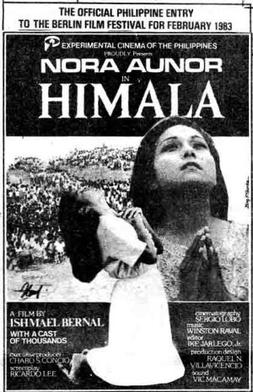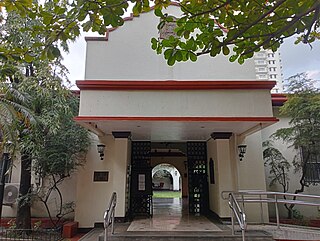
Transportation in the Philippines covers the transportation methods within the archipelagic nation of over 7,600 islands. From a previously underdeveloped state of transportation, the government of the Philippines has been improving transportation through various direct infrastructure projects, and these include an increase in air, sea, road, and rail transportation and transport hubs.

Metropolitan Manila, commonly shortened to Metro Manila and formally the National Capital Region, is the capital region and largest metropolitan area of the Philippines. Located on the eastern shore of Manila Bay, the region lies between the Central Luzon and Calabarzon regions. Encompassing an area of 636.00 km2 (245.56 sq mi) and with a population of 13,484,462 as of 2020, it consists of sixteen highly urbanized cities: Manila—the capital city—Caloocan, Las Piñas, Makati, Malabon, Mandaluyong, Marikina, Muntinlupa, Navotas, Parañaque, Pasay, Pasig, Quezon City, San Juan, Taguig, and Valenzuela, along with one independent municipality, Pateros. As the second most populous and the most densely populated region in the Philippines, it ranks as the 9th most populous metropolitan area in Asia and the 6th most populous urban area in the world.

Manila, officially the City of Manila, is the capital and second-most populous city of the Philippines, after Quezon City. Located on the eastern shore of Manila Bay on the island of Luzon, it is classified as a highly urbanized city. Manila is the world's most densely populated city proper, with 43,611.5 inhabitants per square kilometer (112,953/sq mi) and a population of 1,846,513 people in 2020; it is also the historic core of a built-up area that extends well beyond its administrative limits and includes some 24 million people. Manila was the first chartered city in the country, designated by Philippine Commission Act No. 183 on July 31, 1901. It became autonomous with the passage of Republic Act No. 409, "The Revised Charter of the City of Manila", on June 18, 1949. Manila is considered to be part of the world's original set of global cities because its commercial networks were the first to extend across the Pacific Ocean and connect Asia with the Spanish Americas through the galleon trade. This marked the first time an uninterrupted chain of trade routes circling the planet had been established.

Calabarzon, sometimes referred to as Southern Tagalog and designated as Region IV‑A, is an administrative region in the Philippines. It is situated southeast of Metro Manila and is bordered by Manila Bay and the South China Sea to the west, Lamon Bay and the Bicol Region to the east, Tayabas Bay and the Sibuyan Sea to the south, and Central Luzon to the north. Comprising five provinces—Cavite, Laguna, Batangas, Rizal, and Quezon —and one highly urbanized city, Lucena, it is the most populous region in the Philippines, according to the 2020 census (PSA), with over 16.1 million inhabitants. It is also the country's second most densely populated region, after the National Capital Region. Calamba in Laguna serves as the regional center, while Antipolo in Rizal is the most populous city in the region

The 1954 Asian Games, officially known as the Second Asian Games – Manila 1954 was a multi-sport event held in Manila, Philippines, from May 1 to 9, 1954. A total of 970 athletes from 19 Asian National Olympic Committees (NOCs) competed in 76 events from eight sports. The number of participating NOCs and athletes were larger than the previous Asian Games held in New Delhi in 1951. This edition of the games has a different twist where it did not implement a medal tally system to determine the overall champion but a pointing system. The pointing system is a complex system where each athlete were given points according to their achievement like position in athletics or in swimming. In the end the pointing system showed to be worthless as it simply ranked the nations the same way in the medal tally system. The pointing system was not implemented in future games ever since. Jorge B. Vargas was the head of the Philippine Amateur Athletic Federation and the Manila Asian Games Organizing Committee. With the second-place finish of the Philippines, only around 9,000 spectators attended the closing ceremony at the Rizal Memorial Stadium. The events were broadcast on radio live at DZRH and DZAQ-TV ABS-3 on delayed telecast.

Metropolitan Cebu, or simply Metro Cebu,, is the main urban center of the province of Cebu in the Philippines. Metro Cebu is located along the central eastern portion of the island including the nearby island of Mactan. It accounts for 19.9 percent of the land area and 61.5 percent of the population of the entire province of Cebu.

Himala ('Miracle') is a 1982 Filipino film directed by Ishmael Bernal and produced by the Experimental Cinema of the Philippines. It stars Nora Aunor as a young woman living in the province who claims to have seen a Marian apparition. The film story and script written by Ricky Lee was inspired by a series of alleged Marian apparitions appearing before schoolgirls, which took place from 1966 to 1972 on Cabra Island in Lubang, Occidental Mindoro.

The PAGCOR Tower was a proposed 650 or 655 m tall observation tower near Manila Bay in Parañaque, Metro Manila, Philippines. The tower was meant to be constructed as the landmark of the now opened Pagcor City, an integrated leisure area with hotels, shopping malls, convention centers and casinos. If built, it would have been one of the tallest towers in the world.

World Trade Center Metro Manila (WTCMM) is an exhibition center located in Pasay, Metro Manila, Philippines. The first phase of the venue was inaugurated by then President Fidel Ramos on October 28, 1996.

Tamara Benitez is a Filipina Cinematographer and camera operator, based in Metro Manila, Philippines. Known primarily for her underwater videography, Benitez has worked extensively for the ABS-CBN Corporation and under its production companies Star Cinema and VIVA Films, and has worked with such directors as Lav Diaz, Wenn Deramas, Sig Sanchez, Paolo Herras, and Martin Aviles. She has also worked with Cinematographer Arvin Viola on numerous occasions. Benitez is one of few female Cinematographers working in the cinema of the Philippines. In 2006 she was Director of Photography for the featured pictures Heremias and Lambanog, and in 2011 shot footage for the TV series Survivor India and served as Director of Photography for the TV series Where's Tony.

The Philippine National Shooting Association (PNSA) is the National Sports Association (NSA) governing shooting sports in the Philippines, covering both Olympic discipline shooting sports and non-Olympic shooting events like the bench rest or practical pistol. PNSA is the Philippine shooting sport NSA recognized by and a regular member of the Philippine Olympic Committee (POC), funded by the Philippine Sports Commission (PSC).

Casino Español de Manila is a club established in 1888 by Spaniards living in the Philippines as their exclusive venue for recreational and social activities. It later opened its doors to Filipino members to foster Spanish-Filipino ties in the country. It is located at No. 855 Teodoro M. Kalaw Extension, Ermita, Manila.
Metro Manila, the capital region of the Philippines, is a large metropolitan area that has several levels of subdivisions. Administratively, the region is divided into seventeen primary local government units with their own separate elected mayors and councils who are coordinated by the Metropolitan Manila Development Authority, a national government agency headed by a chairperson directly appointed by the Philippine president. The cities and municipality that form the region's local government units are further divided into several barangays or villages which are headed by an elected barangay captain and barangay council.

Gambling in Metro Manila has been regulated since 1976 when the Philippine Amusement and Gaming Corporation (PAGCOR) was created through Presidential Decree 1067. Under its charter promulgated in 1983, the 100% state-owned PAGCOR, running under the direct supervision of the Office of the President, serves three crucial roles: to regulate and operate all games of chance in the country, particularly casino gaming; generate funds for the government's infrastructure and socio-civic projects; and boost local tourism.

The following outline is provided as an overview of and topical guide to Metro Manila:

My Bebe Love: #KiligPaMore is a 2015 Filipino romantic comedy film directed by Jose Javier Reyes, starring Ai-Ai delas Alas and Vic Sotto with Alden Richards and Maine Mendoza. It is an official entry to the 2015 Metro Manila Film Festival produced by Octo Arts Films, M-Zet Productions, APT Entertainment, GMA Pictures, and MEDA Productions. The film follows the love–hate relationship story between Vito Carillo (Sotto) and Corazon Talatala and the growing relationship between star-crossed lovers Dondi Talatala (Richards) and Anna Carillo (Mendoza).

The squash competitions at the 2019 Southeast Asian Games in the Philippines were held from 1 to 9 December 2019 at the Manila Polo Club in Makati, Metro Manila.
The badminton women's team tournament at the 2019 SEA Games in Manila will be held from 1 to 3 December at the Muntinlupa Sports Complex, Metro Manila, Philippines.
















